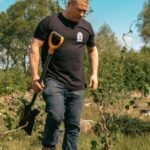A Tree Built for Strength
Hornbeam is famous for the toughness of its wood, which has long been used for tool handles, wheels, and intricate carpentry. The timber’s strength mirrors the tree’s character: resilient, dependable, and hardworking. It thrives in conditions that challenge other trees, growing steadily without demanding attention.
This quiet reliability makes Hornbeam invaluable in woodland restoration. It holds the landscape together, protecting younger and more delicate trees while helping to stabilise the soil. In both life and legacy, it is a tree that endures.
A Haven for Wildlife
Despite its hard wood, Hornbeam has a soft heart for nature. Its catkins appear in spring, offering early pollen for insects, and its small winged seeds, known as samaras, feed finches and other birds through late summer. The leaves support caterpillars, which in turn sustain a variety of songbirds and woodland species.
Its dense crown provides safe nesting sites, while the fallen leaves decompose slowly, creating rich, fertile soil teeming with fungi and beetles. A single Hornbeam sustains a miniature ecosystem, supporting life from its canopy to its roots.
Resilience and Renewal
Hornbeam responds well to coppicing, a traditional woodland practice that allows the tree to regrow after cutting. Each time it is cut back, it sends up new, vigorous shoots, creating a cycle of renewal that supports ground flora, butterflies, and nesting birds. The shifting light and structure in coppiced areas encourage biodiversity, giving each stage of growth a different ecological role.
This ability to regenerate makes Hornbeam both a sustainable resource and a resilient presence in any woodland. It shows that strength and flexibility can coexist, offering lessons for both nature and people.
The Role of Hornbeam in Grown Forest
At Grown Forest, Hornbeam serves as a supporting species that strengthens and stabilises our young woodlands. It buffers wind, creates structure for slower-growing trees, and forms wildlife corridors along woodland edges. Its resilience makes it an ideal tree for changing climates, ensuring that the forests we plant today will endure tomorrow.
When you help plant a Hornbeam, you are adding a guardian to the landscape. It stands quietly, protecting and nourishing its companions while supporting a network of life beneath its branches. Together, we plant not just for today but for the generations who will one day walk beneath its canopy, a living testament to patience, purpose, and strength.

